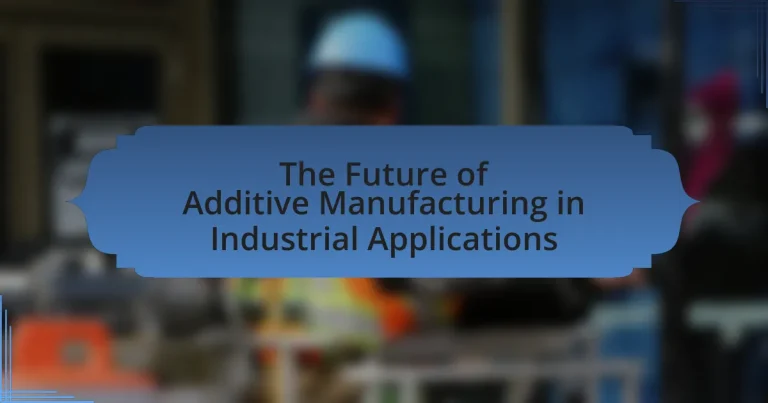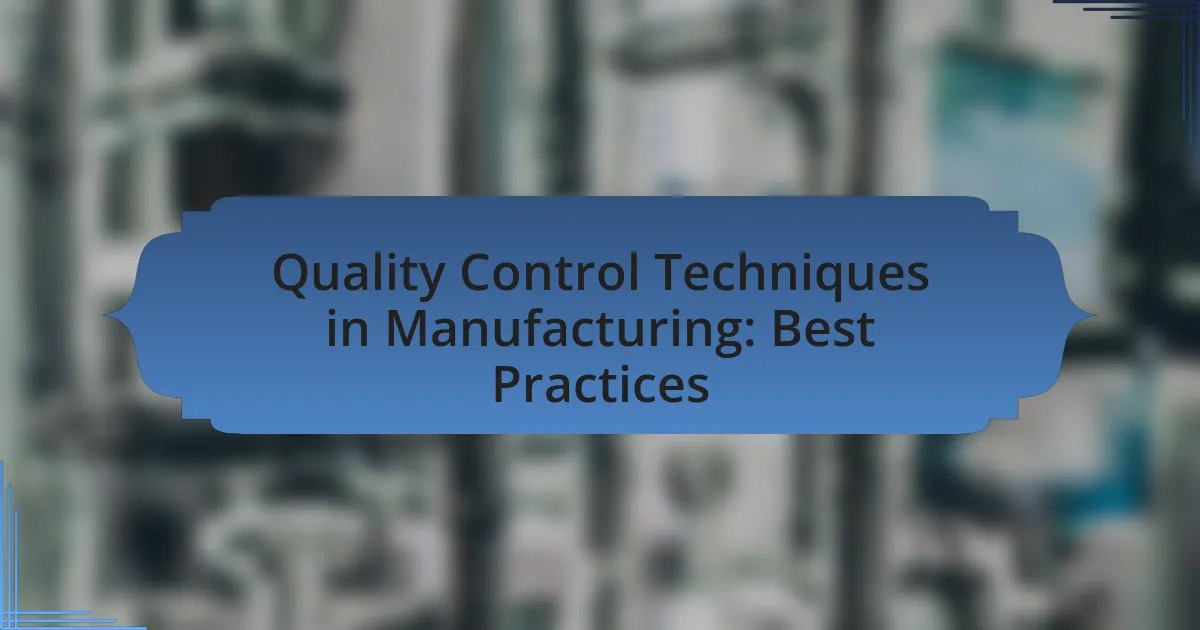The article focuses on the future of additive manufacturing in industrial applications, highlighting its anticipated growth to approximately $35.6 billion by 2025, driven by advancements in technology and materials. It defines additive manufacturing as a process that builds three-dimensional objects layer by layer, contrasting it with traditional manufacturing methods that often involve subtractive processes. Key technologies such as Fused Deposition Modeling and Selective Laser Sintering are discussed, along with trends like increased material diversity and the integration of artificial intelligence. The article also addresses the evolving adoption of additive manufacturing across industries such as aerospace, automotive, and healthcare, while examining challenges like material limitations and regulatory hurdles. Finally, it emphasizes the importance of innovation and workforce adaptation in preparing for the future of this transformative manufacturing approach.
What is the Future of Additive Manufacturing in Industrial Applications?

The future of additive manufacturing in industrial applications is poised for significant growth and innovation, driven by advancements in technology and materials. Industry experts predict that by 2025, the global additive manufacturing market will reach approximately $35.6 billion, reflecting a compound annual growth rate of over 20%. This growth is fueled by the increasing adoption of 3D printing technologies across various sectors, including aerospace, automotive, and healthcare, where customized and complex parts can be produced more efficiently than traditional manufacturing methods. Additionally, the integration of artificial intelligence and machine learning in additive manufacturing processes is expected to enhance production speed and quality, further solidifying its role in industrial applications.
How is additive manufacturing defined in the context of industrial applications?
Additive manufacturing is defined in the context of industrial applications as a process that creates three-dimensional objects by adding material layer by layer, typically using techniques such as 3D printing. This method allows for the production of complex geometries and customized designs that are often difficult or impossible to achieve with traditional manufacturing methods. The industrial application of additive manufacturing has been validated by its use in sectors such as aerospace, automotive, and healthcare, where it enables rapid prototyping, reduced material waste, and shorter lead times for production.
What technologies are included under additive manufacturing?
Additive manufacturing includes several key technologies such as Fused Deposition Modeling (FDM), Stereolithography (SLA), Selective Laser Sintering (SLS), and Digital Light Processing (DLP). FDM utilizes thermoplastic filaments to create objects layer by layer, while SLA employs a UV light source to cure liquid resin into solid parts. SLS uses a laser to fuse powdered materials, typically plastics or metals, into a solid structure. DLP is similar to SLA but uses a digital light projector to cure resin, allowing for faster production times. These technologies are foundational in the field of additive manufacturing, enabling diverse applications across industries.
How does additive manufacturing differ from traditional manufacturing methods?
Additive manufacturing differs from traditional manufacturing methods primarily in its approach to material creation. While traditional manufacturing typically involves subtractive processes, such as cutting or machining materials from a larger block, additive manufacturing builds objects layer by layer from digital models, allowing for more complex geometries and reduced waste. This method can produce intricate designs that are often impossible or cost-prohibitive with traditional techniques, as evidenced by the ability to create lightweight structures in aerospace applications, which can lead to significant fuel savings. Additionally, additive manufacturing enables rapid prototyping and customization, allowing for quicker iterations and tailored solutions in various industries.
What are the key trends shaping the future of additive manufacturing?
Key trends shaping the future of additive manufacturing include increased material diversity, advancements in automation, and the integration of artificial intelligence. Increased material diversity allows for the use of metals, polymers, and composites, enhancing the range of applications in industries such as aerospace and healthcare. Advancements in automation streamline production processes, improving efficiency and reducing costs. The integration of artificial intelligence enables better design optimization and predictive maintenance, leading to higher quality outputs and reduced downtime. These trends are supported by industry reports indicating a projected market growth of additive manufacturing to over $35 billion by 2027, reflecting its expanding role in industrial applications.
How is the adoption of additive manufacturing evolving in various industries?
The adoption of additive manufacturing is rapidly evolving across various industries, driven by advancements in technology and increasing demand for customization. Industries such as aerospace are utilizing additive manufacturing for lightweight components, which can reduce fuel consumption; for instance, Boeing has integrated 3D-printed parts into its aircraft, enhancing performance and efficiency. In the automotive sector, companies like Ford are employing additive manufacturing for prototyping and producing complex parts, which accelerates the design process and reduces costs. The medical field is also experiencing significant growth, with 3D printing being used for custom implants and prosthetics, exemplified by companies like Stratasys, which has developed biocompatible materials for surgical applications. Overall, the trend indicates a shift towards more widespread adoption as industries recognize the benefits of reduced lead times, lower material waste, and enhanced design flexibility.
What role does innovation play in the future of additive manufacturing?
Innovation is crucial for the future of additive manufacturing as it drives advancements in materials, processes, and applications. Continuous innovation enables the development of new materials that enhance performance, such as lightweight composites and bio-compatible substances, which expand the range of industries that can benefit from additive manufacturing. For instance, the introduction of metal 3D printing technologies has revolutionized aerospace and automotive sectors by allowing for the production of complex geometries that were previously impossible with traditional methods. Furthermore, innovations in software and automation improve design capabilities and production efficiency, leading to reduced costs and faster time-to-market. These advancements collectively position additive manufacturing as a transformative force in industrial applications, underscoring its potential to reshape manufacturing paradigms.
What challenges does additive manufacturing face in industrial applications?
Additive manufacturing faces several challenges in industrial applications, including material limitations, scalability issues, and regulatory hurdles. Material limitations arise because not all materials are suitable for additive processes, which restricts the range of applications. Scalability issues occur as many additive manufacturing techniques are not yet capable of producing large quantities efficiently, making them less viable for mass production. Regulatory hurdles exist due to the lack of standardized guidelines for quality assurance and certification, which complicates the adoption of additive manufacturing in industries such as aerospace and medical devices. These challenges hinder the widespread implementation of additive manufacturing in industrial settings.
What are the technical limitations of current additive manufacturing technologies?
Current additive manufacturing technologies face several technical limitations, including material constraints, speed, and precision issues. These technologies often have a limited selection of materials that can be used, which restricts their applicability in various industries. For instance, while metals and plastics are commonly used, the range of high-performance materials suitable for additive manufacturing is still narrow, impacting the mechanical properties of the final products.
Additionally, the speed of production remains a challenge; many additive manufacturing processes are slower compared to traditional manufacturing methods, which can hinder scalability for mass production. Precision is another critical limitation, as achieving tight tolerances and surface finishes can be difficult, leading to post-processing requirements that add time and cost to the manufacturing process.
These limitations are supported by industry reports, such as the Wohlers Report, which highlights ongoing challenges in material diversity and production speed in additive manufacturing.
How do regulatory and compliance issues impact the future of additive manufacturing?
Regulatory and compliance issues significantly impact the future of additive manufacturing by shaping the standards and practices that govern the industry. These regulations ensure product safety, quality, and environmental sustainability, which are critical for gaining acceptance in sectors such as aerospace, medical, and automotive. For instance, the Federal Aviation Administration (FAA) has established guidelines for the certification of 3D-printed parts in aircraft, which influences manufacturers to adhere to stringent quality controls and testing protocols. Compliance with these regulations not only fosters trust among consumers and industries but also drives innovation as companies invest in technologies that meet or exceed regulatory requirements.
How can businesses prepare for the future of additive manufacturing?
Businesses can prepare for the future of additive manufacturing by investing in advanced technologies and training their workforce. This preparation involves adopting state-of-the-art 3D printing technologies, such as metal and polymer additive manufacturing, which are projected to grow significantly, with the global market expected to reach $35.6 billion by 2027 according to a report by MarketsandMarkets. Additionally, companies should focus on developing in-house expertise through training programs that enhance skills in design, engineering, and materials science, as these competencies are crucial for leveraging the full potential of additive manufacturing. By aligning their strategies with industry trends and fostering innovation, businesses can effectively position themselves in the evolving landscape of additive manufacturing.
What skills and knowledge are necessary for workforce adaptation?
Skills and knowledge necessary for workforce adaptation include technical proficiency in additive manufacturing technologies, understanding of materials science, and familiarity with digital design tools. Technical proficiency enables workers to operate and maintain advanced manufacturing equipment, while knowledge of materials science is crucial for selecting appropriate materials for specific applications. Familiarity with digital design tools, such as CAD software, enhances the ability to create and modify designs efficiently. These competencies are essential as industries increasingly integrate additive manufacturing into their processes, reflecting a shift towards more flexible and innovative production methods.
How can companies integrate additive manufacturing into their existing processes?
Companies can integrate additive manufacturing into their existing processes by first assessing their current production workflows to identify areas where additive techniques can enhance efficiency or reduce costs. This integration can involve training staff on additive manufacturing technologies, investing in suitable 3D printing equipment, and developing new design protocols that leverage the unique capabilities of additive manufacturing, such as complex geometries and material optimization.
For instance, a study by Wohlers Associates in 2021 indicated that 60% of companies using additive manufacturing reported improved product design flexibility, demonstrating the tangible benefits of this integration. Additionally, companies can pilot small-scale projects to evaluate the effectiveness of additive manufacturing before scaling up, ensuring that the transition aligns with their operational goals.
What are the potential applications of additive manufacturing in various industries?

Additive manufacturing has potential applications across various industries, including aerospace, automotive, healthcare, and consumer goods. In aerospace, it enables the production of lightweight components, reducing fuel consumption and costs; for instance, Boeing utilizes 3D printing for parts in its 787 Dreamliner. In the automotive sector, companies like Ford and General Motors employ additive manufacturing for rapid prototyping and producing complex parts, which enhances design flexibility and reduces lead times. In healthcare, additive manufacturing is revolutionizing the production of custom prosthetics and implants, with companies like Stratasys creating patient-specific models that improve surgical outcomes. Lastly, in consumer goods, brands are leveraging additive manufacturing for personalized products, allowing for mass customization while maintaining efficiency. These applications demonstrate the transformative impact of additive manufacturing across multiple sectors.
How is additive manufacturing transforming the aerospace industry?
Additive manufacturing is transforming the aerospace industry by enabling the production of complex geometries that are lightweight and optimized for performance. This technology allows for the creation of parts that traditional manufacturing methods cannot achieve, leading to significant weight reductions and improved fuel efficiency. For instance, Boeing has reported that additive manufacturing can reduce the weight of certain components by up to 50%, which directly contributes to lower operational costs and enhanced aircraft performance. Additionally, the ability to produce parts on-demand reduces inventory costs and lead times, further streamlining the supply chain in aerospace manufacturing.
What specific components are being produced using additive manufacturing in aerospace?
Additive manufacturing in aerospace is producing specific components such as fuel nozzles, brackets, and structural parts. For instance, companies like GE Aviation have successfully utilized additive manufacturing to create complex fuel nozzles that are lighter and more efficient than traditionally manufactured counterparts. Additionally, Boeing has implemented additive manufacturing for producing lightweight brackets that reduce overall aircraft weight, contributing to fuel efficiency. These advancements demonstrate the capability of additive manufacturing to enhance performance and reduce costs in aerospace applications.
How does additive manufacturing improve efficiency in aerospace production?
Additive manufacturing improves efficiency in aerospace production by enabling the creation of complex geometries that traditional manufacturing methods cannot achieve. This capability allows for weight reduction in components, which is critical in aerospace applications where every gram counts. For instance, parts produced through additive manufacturing can be up to 70% lighter than their traditionally manufactured counterparts, leading to significant fuel savings and enhanced performance. Additionally, additive manufacturing reduces material waste, as it uses only the necessary amount of material for production, unlike subtractive methods that cut away excess material. This efficiency not only lowers costs but also accelerates production timelines, allowing for faster prototyping and shorter lead times in bringing new aircraft designs to market.
What impact does additive manufacturing have on the automotive sector?
Additive manufacturing significantly impacts the automotive sector by enabling rapid prototyping, customization, and lightweight component production. This technology allows manufacturers to create complex geometries that traditional manufacturing methods cannot achieve, leading to improved performance and efficiency. For instance, companies like BMW and Ford have utilized additive manufacturing to produce parts that reduce vehicle weight, enhancing fuel efficiency. Additionally, a study by the American Society of Mechanical Engineers highlights that additive manufacturing can reduce production time by up to 90%, which accelerates the overall development cycle of new vehicles.
What are the benefits of using additive manufacturing for prototyping in automotive?
Additive manufacturing offers significant benefits for prototyping in the automotive industry, including reduced lead times, cost efficiency, and design flexibility. By enabling rapid production of complex geometries, additive manufacturing allows automotive engineers to iterate designs quickly, which accelerates the development process. For instance, traditional prototyping methods can take weeks or months, while additive manufacturing can produce prototypes in a matter of days. Additionally, the material waste is minimized, as additive processes build objects layer by layer, which is more sustainable compared to subtractive manufacturing methods. This efficiency not only lowers costs but also allows for more innovative designs that can enhance vehicle performance and aesthetics.
How is additive manufacturing used in the production of spare parts for vehicles?
Additive manufacturing is utilized in the production of spare parts for vehicles by enabling the creation of complex geometries and customized components on demand. This technology allows manufacturers to produce lightweight, durable parts that can be tailored to specific vehicle models, reducing inventory costs and lead times. For instance, companies like BMW and Ford have implemented additive manufacturing to produce spare parts, resulting in significant reductions in waste and material usage, as well as the ability to quickly replace obsolete components. This approach not only streamlines the supply chain but also enhances the overall efficiency of vehicle maintenance and repair processes.
How is the medical field benefiting from additive manufacturing?
The medical field is benefiting from additive manufacturing through the production of customized medical devices and implants. This technology allows for the creation of patient-specific solutions, such as prosthetics and dental implants, which enhance fit and comfort. For instance, a study published in the journal “Biofabrication” demonstrated that 3D-printed scaffolds can promote tissue regeneration, showcasing the potential for personalized treatment options. Additionally, additive manufacturing reduces waste and production time, making it a more efficient method for developing complex medical tools.
What types of medical devices are being produced through additive manufacturing?
Additive manufacturing produces various types of medical devices, including custom prosthetics, dental implants, surgical instruments, and bioprinted tissues. Custom prosthetics are tailored to individual patients, enhancing comfort and functionality. Dental implants benefit from precise fabrication, improving fit and integration. Surgical instruments produced through additive manufacturing can be designed for specific procedures, allowing for greater efficiency and effectiveness. Additionally, bioprinted tissues are being developed for research and potential therapeutic applications, showcasing the versatility and innovation of additive manufacturing in the medical field.
How does additive manufacturing contribute to personalized medicine?
Additive manufacturing contributes to personalized medicine by enabling the production of customized medical devices, implants, and prosthetics tailored to individual patient anatomies. This technology allows for the creation of complex geometries and structures that traditional manufacturing methods cannot achieve, resulting in improved fit and functionality. For instance, studies have shown that 3D-printed implants can be designed based on patient-specific imaging data, enhancing surgical outcomes and reducing recovery times. Additionally, additive manufacturing facilitates the development of bioprinted tissues and organs, which hold the potential for personalized drug testing and regenerative medicine applications.
What are the future prospects for additive manufacturing technology?

The future prospects for additive manufacturing technology are highly promising, with significant advancements expected in materials, speed, and applications. Industry experts predict that by 2025, the global additive manufacturing market will reach approximately $35.6 billion, driven by innovations in 3D printing materials and processes. Furthermore, the integration of artificial intelligence and machine learning is anticipated to enhance design capabilities and production efficiency, allowing for more complex geometries and reduced waste. As industries such as aerospace, automotive, and healthcare increasingly adopt additive manufacturing, the technology is set to revolutionize supply chains and enable on-demand production, thereby reducing lead times and costs.
How is research and development influencing the future of additive manufacturing?
Research and development are significantly influencing the future of additive manufacturing by driving innovations in materials, processes, and applications. Ongoing R&D efforts are focused on developing advanced materials that enhance the mechanical properties and thermal stability of 3D-printed components, enabling their use in critical industries such as aerospace and healthcare. For instance, research published in the journal “Additive Manufacturing” highlights the development of high-performance polymers and metal alloys that can withstand extreme conditions, thereby expanding the range of applications for additive manufacturing. Additionally, advancements in process optimization, such as improved printing techniques and automation, are increasing production efficiency and reducing costs, making additive manufacturing more viable for mass production. These developments are crucial as they align with industry demands for customized solutions and rapid prototyping, ultimately shaping the future landscape of industrial applications in additive manufacturing.
What emerging technologies are expected to enhance additive manufacturing capabilities?
Emerging technologies expected to enhance additive manufacturing capabilities include artificial intelligence, advanced materials, and multi-material printing. Artificial intelligence can optimize design processes and improve production efficiency by analyzing data and predicting outcomes. Advanced materials, such as high-performance polymers and metal alloys, enable the creation of stronger and more durable components. Multi-material printing allows for the integration of different materials in a single print, leading to more complex and functional designs. These advancements are supported by ongoing research and development in the field, demonstrating their potential to significantly improve additive manufacturing processes and applications.
How might artificial intelligence and machine learning impact additive manufacturing processes?
Artificial intelligence and machine learning can significantly enhance additive manufacturing processes by optimizing design, improving material usage, and streamlining production workflows. These technologies enable advanced simulations and predictive analytics, allowing for the identification of optimal parameters for printing, which can lead to reduced waste and improved part quality. For instance, AI algorithms can analyze vast datasets from previous manufacturing runs to predict outcomes and adjust settings in real-time, thereby increasing efficiency and reducing errors. Research has shown that integrating AI in additive manufacturing can lead to a 30% reduction in production time and a 20% decrease in material costs, demonstrating the tangible benefits of these technologies in industrial applications.
What are the environmental implications of additive manufacturing?
Additive manufacturing has significant environmental implications, primarily through its potential to reduce waste and energy consumption. Traditional manufacturing processes often involve subtractive methods that generate substantial material waste; in contrast, additive manufacturing builds objects layer by layer, using only the necessary material, which can lead to a reduction in waste by up to 90% in some cases. Additionally, studies indicate that additive manufacturing can lower energy usage by 50% compared to conventional methods, as it often requires less energy-intensive machinery and can produce parts closer to their final destination, minimizing transportation emissions. These factors contribute to a more sustainable manufacturing approach, aligning with global efforts to reduce environmental impact.
How does additive manufacturing contribute to sustainability in industrial applications?
Additive manufacturing contributes to sustainability in industrial applications by significantly reducing material waste and energy consumption. Traditional manufacturing methods often involve subtractive processes that cut away material, leading to up to 90% waste in some cases. In contrast, additive manufacturing builds objects layer by layer, using only the necessary amount of material, which can reduce waste by up to 70%. Additionally, studies show that additive manufacturing can lower energy usage by 50% compared to conventional methods, as it often requires less tooling and fewer resources. This efficiency not only minimizes environmental impact but also promotes a circular economy by enabling the use of recycled materials in production.
What are the waste reduction benefits of additive manufacturing compared to traditional methods?
Additive manufacturing significantly reduces waste compared to traditional manufacturing methods by utilizing only the material necessary to create a part, thereby minimizing excess. Traditional methods, such as subtractive manufacturing, often involve cutting away material from a larger block, resulting in substantial waste—up to 90% in some cases. In contrast, additive manufacturing builds objects layer by layer, which allows for precise material usage and the ability to create complex geometries that would otherwise require additional material in traditional processes. This efficiency not only conserves resources but also lowers production costs and environmental impact, making additive manufacturing a more sustainable option in industrial applications.
What best practices should companies follow when implementing additive manufacturing?
Companies should follow best practices such as conducting thorough research and development, investing in employee training, and ensuring robust quality control when implementing additive manufacturing. Thorough research allows companies to understand the specific technologies and materials that best suit their production needs, while investing in employee training equips staff with the necessary skills to operate and maintain additive manufacturing systems effectively. Additionally, implementing robust quality control measures ensures that the products meet industry standards and specifications, which is crucial for maintaining customer trust and satisfaction. These practices are supported by industry reports indicating that companies that prioritize training and quality control see a significant reduction in production errors and an increase in overall efficiency.
How can organizations assess their readiness for additive manufacturing adoption?
Organizations can assess their readiness for additive manufacturing adoption by conducting a comprehensive evaluation of their current capabilities, resources, and strategic alignment with additive manufacturing technologies. This assessment typically involves analyzing existing infrastructure, workforce skills, and supply chain dynamics to identify gaps and opportunities for integration.
For instance, a study by Wohlers Associates in 2021 indicated that companies with a clear understanding of their operational processes and a skilled workforce are more likely to successfully implement additive manufacturing. Additionally, organizations should consider their financial investment capacity, as the initial costs of adopting additive manufacturing can be significant.
By systematically reviewing these factors, organizations can determine their preparedness and develop a strategic plan for effective adoption of additive manufacturing technologies.
What strategies can enhance the successful integration of additive manufacturing into production lines?
Implementing a structured approach to training and collaboration among teams can significantly enhance the successful integration of additive manufacturing into production lines. This strategy ensures that employees are well-versed in additive manufacturing technologies and can effectively collaborate across departments, leading to improved efficiency and innovation. For instance, companies like General Electric have reported increased productivity and reduced lead times by fostering cross-functional teams that include design, engineering, and production staff, allowing for seamless integration of additive manufacturing processes.




